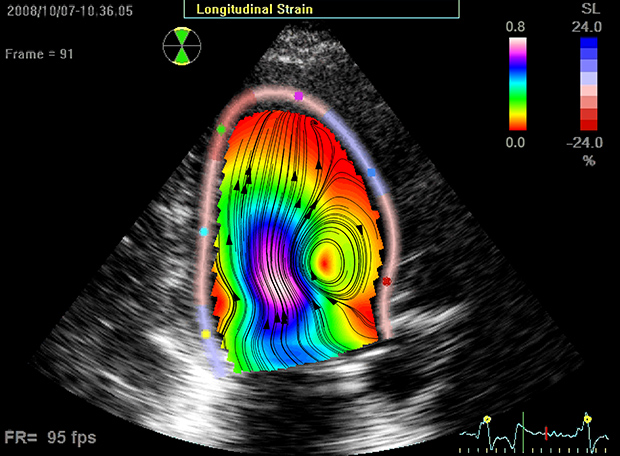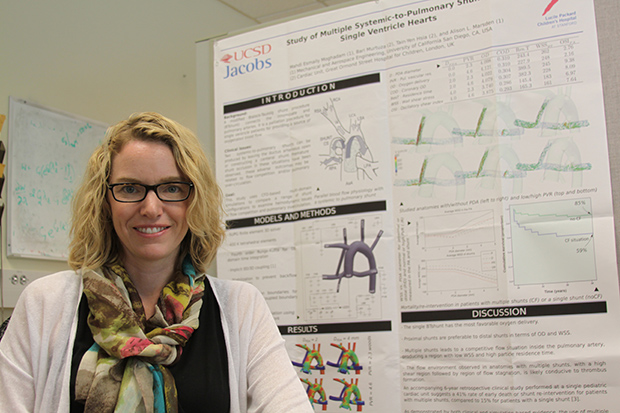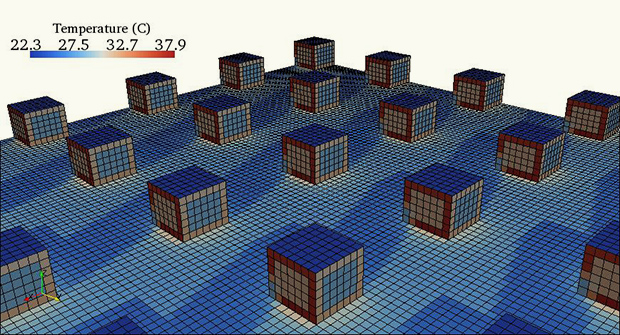
Jacobs School Shines at Fluid Dynamics Conference
By:
- Ioana Patringenaru
- Catherine Hockmuth
Published Date
By:
- Ioana Patringenaru
- Catherine Hockmuth
Share This:
Article Content

An ultrasound image of blood flow in the left ventricle of a patient implanted with a biventricular pacemaker. The flow is organized forming a vortex that redirects blood from the inflow to the outflow tracts of the ventricle.
Simulations that help doctors perform life-saving surgeries; a better way to model climate in urban areas; and optimized blood flow patterns for heart patients with pacemakers. Fluid dynamics researchers from the University of California, San Diego, are discussing their research on these topics—and many others—at the 65th Annual Meeting of the American Physical Society’s Division of Fluid Dynamics here in San Diego Nov. 18 to 20. With about 2,300 contributed presentations, the APS/DFD annual conference is the largest scientific meeting of researchers in fluid dynamics.
A number of UC San Diego Jacobs School of Engineering faculty and students are in the spotlight during the conference. Alison Marsden, a professor of mechanical and aerospace engineering is giving an invited talk about simulation-based planning of surgical interventions in pediatric cardiology. Several other professors at the Jacobs School of Engineering, including Acting Dean Juan C. Lasheras; Sutanu Sarkar, chair of the Department of Mechanical and Aerospace Engineering; and Juan Carlos del Álamo, a professor in the department, are leading discussions on a wide range of topics. In addition, about 60 UC San Diego graduate students are presenting their work at the meeting. Abstracts are available for searching here: http://bit.ly/Sk5Tlp

Alison Marsden, a professor of mechanical and aerospace engineering, wil give an invited talk at the APS DFD meeting.
“The volume and diversity of research projects at DFD from the Jacobs School of Engineering underscores both our strengths in fluid dynamics, as well as the importance of fluid dynamics to a number of vastly different fields from medicine and ocean science to animal behavior and renewable energy,” said Sutanu Sarkar.
Lasheras and Sarkar are the co-chairs of the conference’s organizing committee.
“The APS meeting is the primary gathering place for researchers around the world who specialize in everything fluids-related, from medical devices, to aerospace applications, to the environment,” said Marsden, who also is a part of the medical devices group at the Jacobs School. “It’s important for us to get together as a community to share new ideas, and to give students an opportunity to present their research.”
Marsden is speaking about the blood flow simulations she and colleagues have developed to help surgeons perform high-stakes cardiac surgeries for children. Her group uses patient image data, such as CT or MRI scans, to construct personalized computer models of the arteries and veins; simulate blood flow; and design surgeries that are customized to the patient.
Many of the simulation tools used in this research are similar to those originally developed for aircraft design. Marsden especially focuses on heart disease in children. Some of the designs developed in her lab have been used by pediatric heart surgeons at Stanford to treat children born with only one functioning heart ventricle. She and her students also have developed models of heart damage occurring in Kawasaki Disease in collaboration with physicians at the UC San Diego Medical Center and Rady Children's Hospital. Several of Marsden’s graduate students will present their research at the meeting, along with dozens of others from a wide range of disciplines here at the Jacobs School. KPBS recently profiled her team’s work here http://bit.ly/W5XWBS

A simuation from a complex weather and building model graduate student Neda Yaghoobian developed.
Meanwhile, del Álamo, a professor of mechanical and aerospace engineering, has used fluid mechanics to develop a new method of studying the complex, multidimensional blood flow patterns within the heart, with the ultimate goal of synchronizing blood flow with ventricle wall motion in heart patients with pacemakers. The study is focused on patients with biventricular pacemakers, which are designed to not only control heart rate, but also the timing of specific events in the heartbeat such as the length of time between the contraction of the atrium and the contraction of the ventricle, or the length of time between the contraction of the right ventricle and the left ventricle.
Neda Yaghoobian, a graduate student in the mechanical and aerospace engineering department, showcases a complex weather and building model she developed, called the Temperature of Urban Facets Indoor-Outdoor Building Energy Simulator (TUF-IOBES). The model fills an important gap by allowing the detailed simulation of the interaction between indoor and outdoor climate. The program links indoor and outdoor energy balance dynamically by taking into account real weather conditions, indoor heat sources, building and urban material properties, composition of the building envelope (such as windows and insulation), and waste heat from air conditioning. Yaghoobian developed her model in the research group of Jan Kleissl, a professor of mechanical and aerospace engineering. Read more about her research here: http://bit.ly/SKluLw
Follow the Fluid Dynamics Meeting on the Web
Follow the meeting on Twitter. The official hashtag for the 65th Annual DFD Meeting is #apsdfd
View an extensive list of meeting highlights on the APS website: http://www.aps.org/units/dfd/pressroom/news/index.cfm
Visit the DFD 2012 meeting website: http://apsdfd2012.ucsd.edu/
The DFD’s Gallery of Fluid Motion consists of posters and videos submitted by attendees illustrating the science – and very often also the beauty – of fluid motion. The contributions will be displayed in the Foyer outside of Ballroom 20D on the upper level of the San Diego Convention Center. The award-winning entries will be announced on Tuesday Nov. 20 during the morning coffee break.
Share This:
You May Also Like
Stay in the Know
Keep up with all the latest from UC San Diego. Subscribe to the newsletter today.


